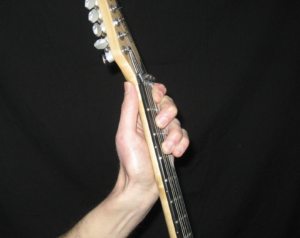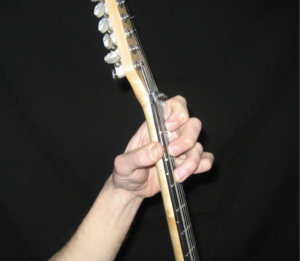Getting Your Fret Hand In The Best Position
By Paul Kleff
Most beginning guitar players have difficulty learning to play chords on the guitar. It is important that you learn the basic open chord fingerings and become fluent at placing your hand into the chord shapes. Until you memorize the chord fingerings, you will not be able to practice getting them to sound good or work on building speed with your chord changes.
The good news is that you do not need to memorize a large number of chord fingerings before you start to work on building your chord change speed—you can start with just two. This lesson will help you learn how to get your fret hand into the best possible position so that you can change chords smoothly and get all the notes in your chords sounding clearly.
Getting your fret hand into the correct position will solve many of your chord problems. First, you will be able to move your fingers easily without any strain. Second, your fingers will approach the fret board more directly so that all the notes will sound clearly in your chords with less fingertip pressure.
Let’s start by looking at the position of your wrist.
Hold up your fret hand in the air like you are raising your hand. Now bend your wrist backward as shown in the picture:
Got it? Now try to move your fingers. Try to move them quickly. It’s not easy, is it?
When your wrist is bent backward, it stretches the tendons in your forearm. This makes it very difficult for you to move your fingers easily. This is the position you do not want to have your fret hand in when you are playing the guitar.
Now place your hand in the position in the next picture:
How does it feel when you try to move your fingers now? It should be a lot easier. When your wrist is not bent backwards, it takes the tension off of the tendons in your arm, which allows your fingers to move freely and easily.
The picture below shows you with the incorrect wrist position looks like on the guitar neck. Notice that the palm of the fret hand is pressed up against the back of the guitar neck. This is the key indicator of a poor wrist position—the back bent wrist. This is the position you do not want your fret hand to be in.
In addition to not being able to move your fingers easily, your fret hand fingers approach the fret board from a side angle. You want your fingers to approach the fret board at an angle that is closer to perpendicular to the fret board. When your fingers approach the strings from the side angle, they are more likely to accidentally touch and mute out neighboring strings. So, not having your wrist back bent solves two key problems: freedom of movement in your fingers, and not accidentally muting strings with your fingertips.
Let’s look at a good fret hand position:
In this position, the fingers can now move easily and the fingertips are not accidentally touching the incorrect strings causing them to mute out.
You can see that your fret hand position plays a big role in your chord changes. Everything starts with the proper set up of your wrist. Don’t let it get back bent and you will be well on your way to great sounding chord changes.
Learn how to play guitar now with fun and easy guitar lessons for beginners. These online guitar lessons will help you build your fundamental guitar skills so that you can learn to play the music you love.





